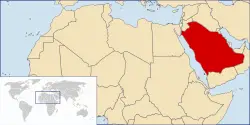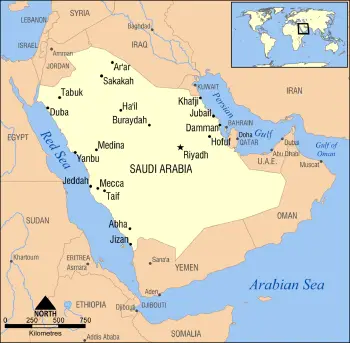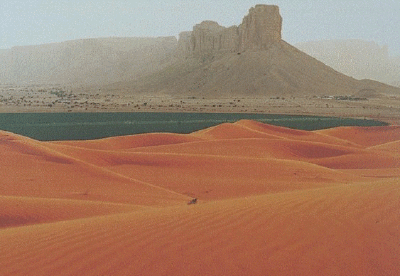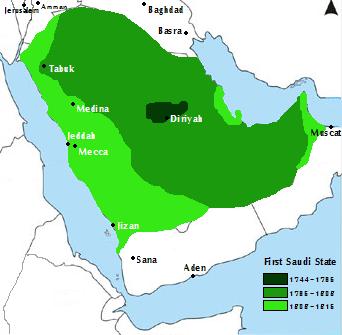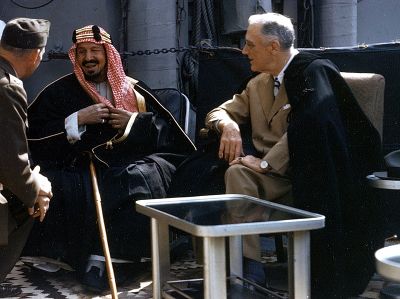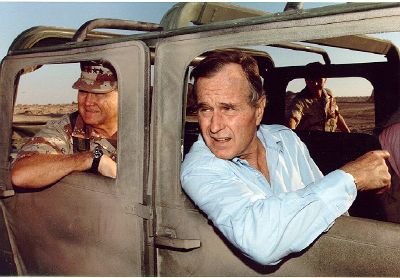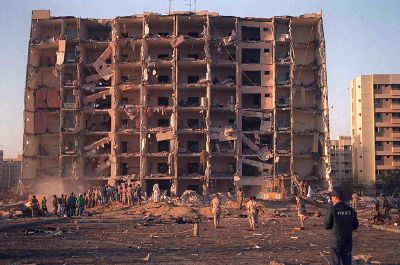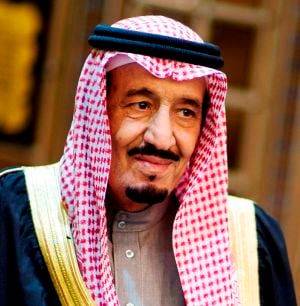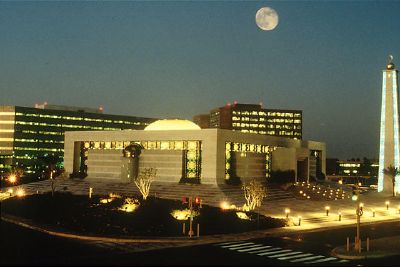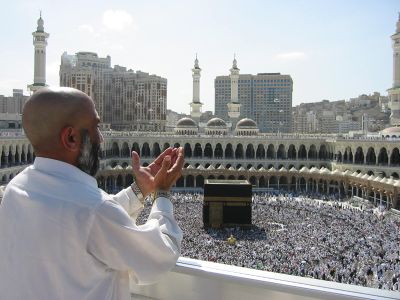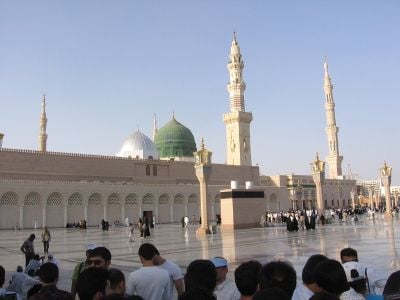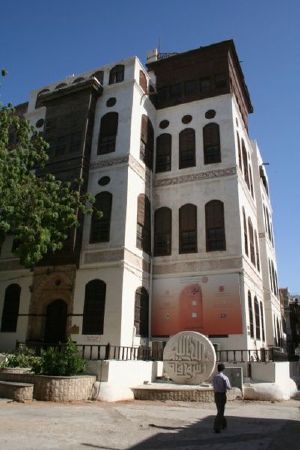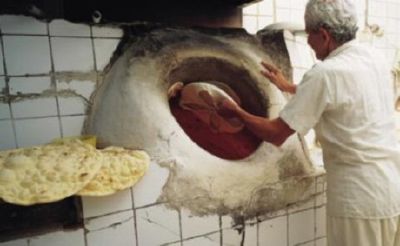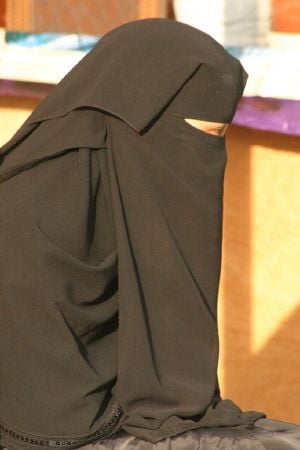Saudi Arabia
| المملكة العربية السعودية al-Mamlakah al-‘Arabiyyah as-Sa‘ūdiyyah Kingdom of Saudi Arabia |
||||||
|---|---|---|---|---|---|---|
|
||||||
| Motto: "لا إله إلا الله , محمد رسول الله
" "There is no god but Allah: Muhammad is the Messenger of Allah" (Shahada)[1] |
||||||
| Anthem: "as-Salām al-Malakiyy" "Long live the King" |
||||||
| Capital (and largest city) | Riyadh 24°39′N 46°46′E | |||||
| Official languages | Arabic | |||||
| Demonym | Saudi Arabian, Saudi (informal) | |||||
| Government | Unitary Islamic absolute monarchy |
|||||
| - | King | Salman bin Abdulaziz | ||||
| - | Crown Prince | Mohammad bin Salman | ||||
| Legislature | None | |||||
| Establishment | ||||||
| - | Kingdom founded | 14 August 1932 | ||||
| Area | ||||||
| - | Total | 2,149,690 km² (13th) 830,000 sq mi |
||||
| - | Water (%) | 0.7 | ||||
| Population | ||||||
| - | 2022 estimate | |||||
| - | Density | 15/km² (174th) 38.8/sq mi |
||||
| GDP (PPP) | 2022 estimate | |||||
| - | Total | $2.0 trillion[3] (17th) | ||||
| - | Per capita | $55,368[3] (25th) | ||||
| GDP (nominal) | 2022 estimate | |||||
| - | Total | $1.04 trillion[3] (18th) | ||||
| - | Per capita | $28,759[3] (35th) | ||||
| Gini (2013) | 45.9[4] | |||||
| Currency | Saudi riyal (SR) (SAR) |
|||||
| Time zone | AST (UTC+3) | |||||
| - | Summer (DST) | (not observed) (UTC+3) | ||||
| Internet TLD | .sa, السعودية. | |||||
| Calling code | [[++966]] | |||||
The Kingdom of Saudi Arabia (Arabic: المملكة العربية السعودية, al-Mamlaka al-ʻArabiyya as-Saʻūdiyya) is the largest country on the Arabian Peninsula.
The Kingdom is sometimes called "The Land of The Two Holy Mosques" in reference to Mecca and Medina, considered by Islam's to be the world's two holiest cities.
Saudi Arabia is the world's leading petroleum producer and exporter, and petroleum exports fuel the Saudi economy. Oil accounts for more than 90 percent of exports and nearly 75 percent of government revenues, facilitating the creation of a welfare state, which the government has found difficult to fund during periods of low oil prices.
The Saudi government requires all citizens to be Muslim, and most of the population adheres to a fundamentalist theological interpretation within Islam most commonly known as Wahhabism. Vast oil revenues gave an immense impetus to the spread of this austere variety of Islamic theology around the world.
Geography
Referred to as “Saudi Arabia” by many English-speaking expatriates, citizens use the Arabic short form of as-Saʻūdiyya (السعودية), but often just refer to the nation as al-Mamlaka (the Kingdom).
Saudi Arabia is bounded by seven countries and three bodies of water. It is bordered by Jordan on the northwest, Iraq on the north and northeast, Kuwait, Qatar, and the United Arab Emirates on the east, Oman on the southeast, and Yemen on the south, with the Persian Gulf to its northeast and the Red Sea and Gulf of Aqaba to its west. Bahrain is an island off the east coast.
The kingdom occupies about 80 percent of the Arabian Peninsula. A significant length of the country's southern borders with the United Arab Emirates, Oman, and Yemen are not precisely defined or marked, so the exact size of the country remains unknown. The Saudi government's estimate is 829,996 square miles (2,149,690 square kilometers). The kingdom is commonly listed as the world's 14th largest nation, or slightly more than one-fifth the size of the United States.
Saudi Arabia's geography is varied. From the western coastal region (Tihamah), the land rises from sea level to a peninsula-long mountain range (Jabal al-Hejaz) beyond which lies the plateau of Nejd in the center. The southwestern 'Asir region has mountains as high as 9840 feet (3000 meters) and is known for having the greenest and freshest climate that attracts many Saudis to resorts such as Abha in the summer months. The east is primarily rocky or sandy lowland continuing to the shores of the Persian Gulf. The geographically hostile Rub' al Khali ("Empty Quarter") desert along the country's imprecisely defined southern borders contains almost no life.
The highest point is claimed to be Jabal Sawda at 10,278 feet (3133 meters), but this elevation is disputed by space shuttle radar data, which also questions the high-point location.
Mostly uninhabited, much of the nation's landmass consists of desert and semi-arid regions, with a dwindling traditional Bedouin population. Desert vegetation is limited to weeds, xerophytic herbs and shrubs. Less than two percent of the kingdom is arable land.
Saudi Arabia has no permanent year-round rivers or lakes. Its coastline extends for 1640 miles (2640km) and, on the Red Sea side, offers world-class coral reefs, including those in the Gulf of Aqaba.
Native animals include the ibex, wildcats, baboons, wolves, and hyenas in the mountainous highlands. Small birds are found in the oases. The coastal area on the Red Sea with its coral reefs has a rich marine life.
Extreme heat and aridity are characteristic of most of Saudi Arabia. Summer temperatures above 120°F (50°C) are common, while in winter frost or snow can fall in the interior and the higher mountains. The average winter temperature range is 47°F to 68°F in January in interior cities such as Riyadh (8°C to 20°C), and 66°F to 83°F (19°C to 29°C) in Jeddah on the Red Sea coast. The average summer range in July is 81°F to 109°F (27°C to 43°C) in Riyadh and 80°F to 100°F (27°C to 38°C) in Jeddah. Night-time temperatures in the mid desert can be famously chilly even in summer, as sand gives up daytime heat rapidly once the sun has set.
Annual precipitation is usually sparse (up to four inches or 100mm or in most regions) between January and May, although sudden downpours can lead to violent flash floods in wadis. Plants can still survive in Saudi Arabia, mostly in the south-east mountains and lowlands. They bloom mid-March through mid-May. The plants provide food for birds and insects. Rainfall is adequate for the nomadic herding of sheep, goats, and camels, but crop production depends on irrigation from underground aquifers.
Natural hazards include frequent sand and dust storms. Environmental issues include coastal pollution from oil spills, desertification, and the depletion of underground water resources. The lack of perennial rivers or permanent water bodies has prompted the development of extensive seawater desalination plants.
Population centers are mainly located along the eastern and western coasts and densely populated interior oases such as Hofuf and Buraidah. In some extended areas, primarily the Rub' al-Khali and the Arabian Desert and East Sahero-Arabian xeric shrub lands, there is no population whatsoever, although the petroleum industry is constructing a few planned communities there.
Riyadh is the capital; Jeddah, is the second largest city, is the main Red Sea port, and is a pilgrimage gateway to Mecca; Dammam is the eastern province capital, and third largest metropolitan area; Mecca is the holiest city in Islam; Medina is the second holiest city; and Ta'if is a mountain resort above Mecca.
History
People of various cultures have lived in the peninsula over a span of more than 5000 years. The Dilmun culture, along the Persian Gulf coast (c. 3000 – 1600 B.C.E.), was contemporaneous with the Sumerians and ancient Egyptians, and the empires of the ancient world traded with peninsula states. Except for a few cities and oasis, the harsh climate prevented much settlement on the Arabian Peninsula.
The earliest known events in Arabian history are migrations from the peninsula into neighboring areas. About 3500 B.C.E., semitic-speaking peoples of Arabian origin migrated into the valley of the Tigris and Euphrates rivers in Mesopotamia and became the Assyro-Babylonians. Some archaeologists argue that another group of Semites left Arabia about 2500 B.C.E., during the Early Bronze Age, and settled along the Levant. Mixing with the local populations there, some of these migrants became the Amorites and Canaanites. Some archaeologists argue that the migration, instead, came from the northern Levant.
Significant between 3000 and 2500 B.C.E. was the domestication of the one-humped camel, or dromedary, in the southern part of the Arabian Peninsula. By 1000 B.C.E., such camels were important in the caravan trade. The camel saddle was invented between about 500 and 100 B.C.E.
Islam
Present day Saudi Arabia is the location of the birth of the Prophet Muhammad (c. 570 C.E.) in Mecca, and of the religion of Islam. Muslims believe that God (Allah) sent His final revelation "in clear Arabic," in the form of the holy Koran, through His Messenger, Muhammad. This occurred first in and around Mecca and then in Medina beginning in 622 C.E., which marks the first year of the Islamic era (1 A.H.). By the time Muhammad died (in Medina in 632 C.E.), almost all communities in Arabia had declared loyalty to him as a political leader and to Islam. Muslims view Muhammad not as the creator of a new religion, but as the restorer of the original, uncorrupted monotheistic faith of Adam, Abraham, Moses and Jesus. Islam's first caliph Abu Bakr completed the process of conversion. Arabian converts carried the religion throughout the Middle East and north Africa. The rise of Islam and the subsequent religious importance of the Arabian cities of Mecca and Medina (two of the holiest places in Islam), have given the rulers of this territory significant influence beyond the peninsula.
First Saudi State
The first Saudi state was established in 1744, when leader Sheikh Mohammed ibn Abd al Wahhab settled in Diriyah and Prince Mohammed Ibn Saud agreed to support and espouse his cause. After studying in the Hijaz and Iraq, Sheikh Muhammad Al Abd al-Wahab (who died in 1792), returned to Najd and preached and wrote against practices that deviated from Islam. He urged his followers, who became known as muwahidun ("unitarians"), to end polytheistic practices and adhere strictly to the Koran and the Hadith (the sayings and doings of the Prophet). A new leadership structure placed Al Saud in the position of umara (princes, rulers) and Al Abd al-Wahab (also known as Al Sheikh) in the position of ulama (learned in religion).
The movement involved military struggle, preaching, the establishment of Koranic schools, the setting up of new communities, and the creation of a bureaucratic state that ruled in Najd. The House of Saud, with other allies, rose to become the dominant state in Arabia controlling most of the Nejd, but not either coast. This Saudi state lasted for about 75 years. Rulers of the first Saudi state were: Imam Mohammed Ibn Saud (1726 –1765), Imam Abdul Aziz Ibn Mohammed Ibn Saud (1765 – 1803), Imam Saud Ibn Abdul Aziz Ibn Mohammed Ibn Saud (1803 – 1814) and Imam Abdullah bin Saud (1814 – 1818).
Concerned at the growing power of the Saudis the Ottoman Sultan instructed Mohammed Ali Pasha to reconquer the area. Ali sent his sons Tusun Pasha and Ibrahim Pasha who were successful in routing the Saudi forces in 1818.
Second and third Saudi states
The House of Saud returned to power in the second Saudi state in 1824. The state lasted until 1891 when it succumbed to the Al Rashid dynasty of Ha'il. In 1902, Abdul Aziz Ibn Saud captured Riyadh, the Al-Saud dynasty's ancestral capital, from the rival Al-Rashid family. Continuing his conquests, Abdul Aziz subdued Al-Hasa, the rest of Nejd, and the Hejaz between 1913 and 1926. On January 8, 1926, Abdul Aziz Ibn Saud became the King of Hejaz. On January 29, 1927, he took the title King of Nejd (his previous Nejdi title was sultan). By the Treaty of Jeddah, signed on May 20, 1927, the United Kingdom recognized the independence of Abdul Aziz's realm (then known as the Kingdom of Hejaz and Nejd). In 1932, these regions were unified as the Kingdom of Saudi Arabia.
Oil discovered
The discovery of oil on March 3, 1938, transformed the country. Development programs, which were delayed due to the onset of the Second World War in 1939, began in earnest in 1946 and by 1949 production was in full swing. Oil has provided Saudi Arabia with economic prosperity and a great deal of leverage in the international community. Boundaries with Jordan, Iraq, and Kuwait were established by a series of treaties negotiated in the 1920s, with two neutral zones created, one with Iraq and the other with Kuwait.
Isolationist policy
Internationally Abdul Aziz initially chose to follow an isolationist policy. He refused to allow Saudi Arabia to join the League of Nations, and he chose to leave his kingdom on only three occasions from 1916 until his death in 1953. Eventually however Abdul Aziz acceded to the realities of world politics and in 1945 Saudi Arabia became a founding member of the Arab League and joined the United Nations.
Aware of the difficulties facing other regional absolute rulers reliant on extended family networks, Abdul Aziz took steps to provide that his eldest living son, Saud, would become king, but that he would be required to work closely with his more financially and diplomatically astute brother, Faisal.
Saud and Faisal
Saud ascended to the throne on his father's death in 1953, and reigned for 11 years. But by the early 1960s, the kingdom was in jeopardy due to Saud's economic mismanagement and his failure to deal with a regional challenge from Egyptian president Gamal Abdel Nasser. Because of fiscal difficulties, King Saud had been persuaded in 1958 to delegate direct conduct of Saudi Government affairs to his half-brother Faisal as prime minister. In October 1962, Faisal outlined a broad reform program, stressing economic development. In 1964 Saud was forced to abdicate in favor of Faisal, who continued to serve as prime minister. Subsequent kings followed this practice.
Neighboring wars
The mid-1960s saw external pressures generated by Saudi-Egyptian differences over Yemen. When civil war broke out in 1962 between Yemeni royalists and republicans, Egyptian forces entered Yemen to support the new republican government, while Saudi Arabia backed the royalists. Tensions subsided only after 1967, when Egypt withdrew its troops from Yemen.
In 1965, there was an exchange of territories between Saudi Arabia and Jordan in which Jordan gave up a relatively large area of inland desert in return for a small piece of sea-shore near Aqaba.
Saudi forces did not participate in the Six-Day (Arab-Israeli) War of June 1967, but the government later provided annual subsidies to Egypt, Jordan, and Syria to support their economies. During the Yom Kippur War in 1973, Saudi Arabia participated in the Arab oil boycott of the United States and the Netherlands. A member of the Organization of Petroleum Exporting Countries (OPEC), Saudi Arabia had joined other member countries in moderate oil price increases beginning in 1971. After the 1973 war, the price of oil rose substantially, dramatically increasing Saudi Arabia's wealth and political influence.
King Fahd period
In 1975, King Faisal was assassinated by a nephew, and was succeeded by his half-brother Khalid as king and prime minister. Their half-brother, Prince Fahd, was named crown prince and first deputy prime minister. King Khalid empowered Crown Prince Fahd to oversee many aspects of the government's affairs. Economic development continued rapidly under King Khalid, and the kingdom assumed a more influential role in regional politics and international economic and financial matters.
In June 1982, King Khalid died, and Fahd became king and prime minister in a smooth transition. Another half-brother, Prince Abdullah, Commander of the Saudi National Guard, was named crown prince and first deputy prime minister. King Fahd's brother, Prince Sultan, the minister of defense and aviation, became second deputy prime minister. Under King Fahd, the Saudi economy adjusted to sharply lower oil revenues resulting from declining global oil prices. Saudi Arabia supported neutral shipping in the Gulf during periods of the Iran-Iraq war and aided Iraq's war-strained economy. King Fahd played a key role in bringing about the August 1988 cease-fire between Iraq and Iran and in organizing and strengthening the Gulf Cooperation Council.
Gulf War
In August 1990, Saddam Hussein's forces invaded Kuwait. Iraqi troops began massing on the border of Kuwait and some feared that they were about to invade Saudi Arabia. King Fahd allowed American and coalition soldiers to be stationed in Saudi Arabia to counter the Iraqi threat. Many Muslims were angered by this move, because it allowed foreign armies to be stationed in their holiest land.
Saudi Arabia accepted the Kuwaiti royal family and 400,000 refugees while allowing Western and Arab troops to deploy on its soil for the liberation of Kuwait the following year. King Fahd's action also consolidated the coalition of forces against Iraq and helped define the tone of the operation as a multilateral effort to re-establish the sovereignty and territorial integrity of Kuwait. Acting as a rallying point and personal spokesman for the coalition, King Fahd helped bring together his nation's Gulf Cooperation Council allies, Western allies, and Arab allies, as well as non-aligned nations from Africa and the emerging democracies of eastern Europe. He used his influence as custodian of the two holy mosques to persuade other Arab and Islamic nations to join the coalition.
During the Gulf War, Iraq fired Scud missiles into Saudi Arabia and penetrated its northern border. These attacks were repelled, and Iraqi forces were expelled from Kuwait. American forces as well as some multinational contingents continued to occupy bases in the kingdom.
Terrorism
The stationing of Western troops on Saudi territory angered many Muslims, and led radicals to declare a religious war against the United States. One of these was Osama bin Laden, a wealthy Saudi expelled in 1991 after he voiced opposition to the monarchy, and a key ally of the United States in the early Soviet war in Afghanistan.
In November 1995, a Saudi National Guard base was bombed, killing seven people. In June 1996, a truck bomb killed 19 American servicemen in Al-Khobar. These bombings caused the monarchy to focus on militancy inside the kingdom, yet they denied there was much of a problem.
After the September 11, 2001 attacks on the New York City World Trade towers, it became known that 15 of the 19 suspected hijackers were Saudi, the kingdom became the focus of worldwide attention once again, as it was questioned whether the government was indeed cracking down on radicals. The Saudi government pledged their support to the “war on terror,” and vowed to try to eliminate militant elements.
However, in May 2003, an insurgency in Saudi Arabia began, believed to be conducted by al-Qaeda affiliates. This consisted mainly of attacks on foreigners in an attempt to expel them from the country and hurt the Saudi government. While the number of attacks dropped significantly in 2005, they exposed the vulnerability of the country.
Concern was also voiced over the large numbers of Saudis fighting American soldiers in Iraq following the 2003 invasion. It was suspected that these fighters, many of them young, had become radicalized in Saudi mosques and were traveling to Syria and then into Iraq.
King Fahd suffered a stroke in November 1995, and died in July 2005. He was succeeded by his brother Crown Prince Abdullah, who had handled most of the day-to-day operations of the government.
Government and politics
Saudi Arabia has never been a colony of a foreign power or a province of the Ottoman Empire. The nation of Saudi Arabia evolved from tribal origins, with financial assistance from merchants, knowledge imparted by imams and teachers, and bureaucratic work done by jurists and bureaucrats.
The politics of Saudi Arabia take place in a framework of an absolute monarchy whereby the king of Saudi Arabia is not only head of state, but also the head of government. The Basic Law adopted in 1992 declared that Saudi Arabia is a monarchy ruled by the sons and grandsons of King Abd Al Aziz Al Saud, and that the Qur'an is the constitution of the country, which is governed on the basis of Islamic (Shari'a) law. The state's ideology is Wahhabism, which the Saudi government spreads around the world by funding the construction of mosques and Qur'an schools.
A council of ministers (cabinet) is appointed by the monarch every four years and includes the king and royal family members among its 20 ministers. There are no elections since the monarch is hereditary. Abdullah bin Abdulaziz Al Saud was king and prime minister from August 2005 until his death in January 2015. He was succeeded by King Salman, full brother of King Fahd who was king from 1982 to 2005, and half-brother to King Abdallah, after two Crown Princes (Prince Sultan and Prince Nayef) predeceased him. The king's powers are theoretically limited within the bounds of Shari'a and other Saudi traditions. He must retain a consensus of the Saudi royal family, religious leaders, and other important elements in Saudi society.
The royal family, which consists of more than 20,000 people and has several clans, has significant political influence. The family's vast numbers allow it to control most of the kingdom's important posts and to have an involvement and presence at all levels of government. The ulama, which consists of members of the royal family and several thousand religious scholars, judges, lawyers, seminary teachers, and imams, plays an important leadership role. Business and merchant families often exert political influence. There are no labor unions or syndicates for professional groups.
As the main executive organ, the Council of Ministers heads 20 ministries, the national guard, several provincial governors, the monetary agency, as well as the petroleum and mineral organization. The kingdom has a large civil service that employed about 400,000 people in the early 1990s. Saudi Arabia has 14 provinces, each governed by an emir, usually from the royal family, who reports to the minister of the interior.
The legislature comprises a consultative council or Majlis al-Shura of 150 members and a chairman appointed by the monarch for a four-year term. The consultative assembly has limited legislative rights. Legislation is by resolution of the Council of Ministers, ratified by royal decree, and must be compatible with the Shari'a. There are no recognized political parties or national elections, except the local elections, which were held in the year 2005.
Shari'a justice
Justice is administered according to the Shari'a by a system of religious courts whose judges are appointed by the king on the recommendation of the Supreme Judicial Council, composed of 12 senior jurists. The independence of the judiciary is protected by law. A court of cassation, or appeals court, also exists, and a final appeal may be made to the king. Access to high officials (usually at a majlis; a public audience) and the right to petition them directly are well-established traditions.
Saudi Arabia does not have much of a formal criminal code, and thus much of its law is derived from its ultra-conservative Wahhabism. Judges are free to impose capital punishment or corporal punishment, including amputations of hands and feet for certain crimes such as murder, robbery, rape, drug smuggling and for various forms of sexual behavior such as homosexuality and adultery. The courts may impose less severe punishments, such as floggings, for less serious crimes against public morality such as drunkenness.
A powerful deterrent is that deviant behavior brings shame to one's family and kin and is considered sinful. Any physical punishment is carried out in a public place, usually outside a main mosque on Friday. The criminal's name and ancestral names are called out loudly; the shame is more painful than the physical blow. Judges are generally given a tremendous amount of discretion in deciding how to punish a particular individual, and will make such decisions based on the particular school of Islam that they follow. For example:
- Theft is punishable by the amputation of the right hand, unless the thief is poor and the stolen money is from public sources or a company. Saudi authorities are at pains to point out that this punishment is for repeat offenders only. (An anesthetic is used to deaden the pain.)
- Drinking, selling, or buying alcohol and sniffing or injecting drugs is punished by a sentence of 80 lashes. Smuggling heroin or cocaine into the country is punished by death (beheading with a sword).
- Fornication is normally punished with 40 lashes. During flogging, the face, head and vital organs of the person are protected.
- Adultery can only be proven by the testimony of four reliable witnesses. Death by stoning is the punishment. (The convicted adulterer is drugged before stoning begins.)
- Murder, accidental death and bodily harm are open to punishment from the victim's family. Retribution may be sought in kind or through blood money. The blood money payable for a woman's accidental death is half as much as that for a man.
The crime rate in Saudi Arabia is low compared to more industrialized countries. A comparison was for the year 2000 using Interpol data for Saudi Arabia, Japan (a country with a low crime rate) and the U.S. (a high crime rate) drawn for the seven offenses used to compute the U.S. Federal Bureau of Investigation's index of crime—murder, forcible rape, robbery, aggravated assault, burglary, larceny, and motor vehicle theft. The rate for all offenses combined was 157.12 for Saudi Arabia, compared with 1709.88 for Japan and 4123.97 for the U.S.
Human rights
Human Rights Watch, Amnesty International and the United Nations Human Rights Committee have issued reports critical of the Saudi legal system and its human rights record in various political, legal, and social areas. The Saudi government dismisses such reports as being outright lies or asserts that its actions are based on its adherence to Islamic law. In 2002, the United Nations Committee against Torture criticized Saudi Arabia over the amputations and floggings it carries out. The Saudi delegation responded, defending its legal traditions held since the inception of Islam in the region 1400 years ago and rejected "interference" in its legal system.
Opposition movements
There have been two serious attempts to overthrow the Saudi royal family. The first was on November 20, 1979, when heavily armed and provisioned Sunni Islamic fundamentalists, consisting of Saudis and Egyptians enrolled in Islamic studies at the Islamic University of Medina, took over and besieged Al-Masjid al-Haram in Mecca. The other was in the year 1980 by Shia Muslims in the eastern part of the country, a movement allegedly supported by the Iranian government.
The main opponents of the government in 2007 were the Movement for Islamic Reform in Arabia and al-Qaeda. The Movement for Islamic Reform is a United Kingdom-based Saudi opposition organization headed by Dr. Sa'ad Al-Faqih, who has been a key figure in the reform movement in Saudi Arabia since the gulf war. According to a 2005 United States Department of State report on human rights in Saudi Arabia, MIRA was founded in 1996 as a splinter of the Committee for the Defense of Legitimate Rights, both of which "continued to advocate overthrowing the [Saudi] monarchy by force."
Al-Qaeda (a name that means "the base," referring to a base camp in Afghanistan) is an international alliance of militant jihadist organizations established by Saudi-born Osama bin Laden and others around the time of the Soviet withdrawal from Afghanistan in 1989. Al-Qaeda's objectives include the elimination of foreign influence in Muslim countries, eradication of those deemed to be "infidels," elimination of Israel, and the creation of a new Islamic caliphate. The United Nations Security Council has labeled al-Qaeda a terrorist organization. Its affiliates have executed attacks against targets in various countries, the most prominent being the September 11, 2001, attacks in New York City and Washington, DC. Following those attacks, the United States government launched a broad military and intelligence campaign known as the War on Terrorism, with the stated aim of dismantling al-Qaeda and killing or capturing its operatives.
Military
The Saudi military was founded as the Ikhwan army, the tribal army of Ibn Saud. The Ikhwan had helped King Ibn Saud conquer the Arabian Peninsula during World War I. By expanding the military forces years later, Saudi Arabia today has many military branches. Those branches include the army, air force, and navy. Independent military branches include the National Guard, and the Royal Guard. The Ministry of Interior has the police, border guard, coast guard, Al-Mujahidoon, and the Saudi Emergency Force.
Economy
Saudi Arabia has an oil-based economy with strong government controls. The nation possesses oil reserves of 262.7-billion barrels, or 25 percent of the world's proven petroleum reserves, ranks as the largest exporter of petroleum, and plays a leading role in the Organization of Oil Producing and Exporting Countries (OPEC). The petroleum sector accounts for roughly 75 percent of budget revenues, 45 percent of Gross Domestic Product (GDP), and 90 percent of export earnings. About 40 percent of GDP comes from the private sector.
The government is encouraging private sector growth to lessen the kingdom's dependence on oil and to increase employment opportunities for the swelling Saudi population. The government is promoting private sector and foreign participation in power generation, telecom, natural gas, and petrochemical industries. Saudi Arabia acceded to the World Trade Organization in December 2005 after many years of negotiations. With high oil revenues enabling the government to post large budget surpluses, Riyadh has substantially boosted spending on job training and education, infrastructure development, and government salaries.
The government announced plans to establish six "economic cities" in different regions to promote development and diversification. One such new city is King Abdullah Economic City, located along the coast of the Red Sea, around 100 km north of Jeddah.
Challenges
The combination of relatively high oil prices and exports led to a revenue windfall for Saudi Arabia during 2004 and early 2005. But Saudi Arabia's per capita oil export revenues remain far below high levels reached during the 1970s and early 1980s. In 2004, Saudi Arabia earned around $4564 per person, versus $22,589 in 1980. This 80 percent decline in real per capita oil export revenues since 1980 is in large part due to the fact that the nation's young population has nearly tripled since 1980, while oil export revenues in real terms have fallen by over 40 percent. Meanwhile, Saudi Arabia has faced heavy budget and trade deficits.
Other economic challenges include high rates of unemployment (12 percent of Saudi nationals, one of the world's fastest population growth rates, and the consequent need for increased government spending. The kingdom is facing security threats, including a number of terrorist attacks (on foreign workers, primarily) in 2003 and 2004. In response, the Saudis reportedly increased spending in the security area.
Water supply and sanitation
Water supply and sanitation in Saudi Arabia is characterized by significant investments in seawater desalination, water distribution, sewerage and wastewater treatment leading to a substantial increase in access to drinking water and sanitation over the past decades. About 50 percent of drinking water comes from desalination, 40 percent from the mining of non-renewable groundwater and 10 percent from surface water, especially in the mountainous southwest of the country. The capital Riyadh, located in the heart of the country, is supplied with desalinated water pumped from the Persian Gulf over a distance of 467 km.
Given the substantial oil wealth, water is provided almost for free. Since 2000, the government has increasingly relied on the private sector to operate water and sanitation infrastructure, beginning with desalination and wastewater treatment plants. Since 2008, the operation of urban water distribution systems is being gradually delegated to private companies as well.
Demographics
The population of Saudi Arabia is estimated to be around 35 million, though the Saudi population has long proved difficult to accurately estimate due to Saudi leaders' historical tendency to artificially inflate census results. Saudi population has grown rapidly since 1950 when it was estimated to be 3 million. Immigrants now make up over 30 percent of the population.[4]
The ethnic composition of Saudi citizens is 90 percent Arab and 10 percent Afro-Asian.[4] Most Saudis live in Hejaz (35 percent), Najd (28 percent), and the Eastern Province (15 percent). Hejaz is the most populated region in Saudi Arabia.
As late as 1970, most Saudis lived a subsistence life in the rural provinces, but in the last half of the 20th century the kingdom has urbanized rapidly. By 2012 about 80 percent of Saudis lived in urban metropolitan areas—specifically Riyadh, Jeddah, or Dammam.
As recently as the early 1960s, Saudi Arabia's slave population was estimated at 300,000. Slavery was officially abolished in 1962.
Ethnicity
Around 90 percent of Saudis are ethnically Arab.[4] There are some citizens of Asian and sub-Saharan/East African ancestry. Hundreds of thousands of low-skilled workers and skilled workers from regions of the developing world migrate to Saudi Arabia, sometimes only for a short period of time, to work. The kingdom attracts skilled experts in the banking and services professions. It is reported that some guest workers are sometimes subject to mistreatment. Migrants come from countries all around the world, and include: Indian 1.4 million, Bangladeshi 1 million, Filipino 950,000, Pakistani 900,000, and Egyptian 750,000. Many Arabs from nearby countries are employed in the kingdom. There are around 100,000 Westerners in Saudi Arabia, most of whom live in compounds or gated communities.
As Muslims, Saudi Arabians belong to a community in which issues of race, ethnicity, and national origin should be of no significance. But the concept of origin is strong. Some people in Hijaz are descendants of Muhammad and are known as Ashraf. Others claim descent from ancient Arab tribes. The more prominent cultural division is between citizens and immigrants.
Religion
The Saudi government requires all citizens to be Muslim, and most of the population adheres to Wahhabism. The Shia population is estimated at around 15 percent, primarily in the eastern provinces, and larger cities. The country allows Christians and Hindus to enter the country as temporary workers, but does not allow them to practice their faiths. The public practice of any religion other than Islam, the presence of churches, and the possession of non-Islamic religious materials is not allowed. The U.S. State Department suggests that there are 500,000 to one million people who adhere to the Catholic faith.
Every day, five times a day, Muslims are called to prayer from the minarets of mosques which dot the country. The weekend consists of Thursday and Friday. All Muslims are obliged to make the Hajj, or pilgrimage to Mecca, at least once during their lifetime. The cultural environment in Saudi Arabia is highly conservative.
Wahhabism is a branch of Islam practiced by those who follow the teachings of Muhammad ibn Abd-al-Wahhab, who reintroduced Shariah (Islamic) law to the Arabian Peninsula in 1744. The term "Wahhabi" is rarely used by the people it is used to describe. The preferred term is "Salafism" from Salaf as-Salih, the "pious predecessors." Wahhabi theology treats the Qur'an and Hadith as fundamental texts, interpreted upon the understanding of the first three generations of Islam and further explained by various commentaries, including Ibn Abd al-Wahhab's book called Kitab al-Tawhid ("Book of Monotheism").
In 1924, members of the al-Saud dynasty, who were influenced by the teachings of Abdul Wahhab, conquered Mecca and Medina, the Muslim holy cities. This gave them control of the Hajj, the annual pilgrimage, and the opportunity to preach their version of Islam to the assembled pilgrims. Wahhabism remained a minor current within Islam until the discovery of oil in Arabia, in 1938. Vast oil revenues gave an immense impetus to the spread of the conservative theology. Saudi laypeople, government officials and clerics have donated many tens of millions of U.S. dollars to create religious schools, newspapers and outreach organizations.
Language
Arabic is the language of all Saudi Arabian citizens and about half the immigrants. It is the largest living member of the Semitic language family in terms of speakers. Classified as Central Semitic, it is closely related to Hebrew and Aramaic. Classical Arabic is used for prayers and religious rituals, poetry, lectures, speeches, broadcasts, written communications, and other formal purposes. Colloquial Arabic is used in conversation. There are numerous dialects. English is the main second language.
Men and women
Men and women are not permitted to attend public events together and are segregated in the work place. Women are employed in girls' schools and the women's sections of universities, social work and development programs for women, in banks for woman clients, medicine and nursing for women, television and radio programming, and computer and library work. Only about seven percent of the workforce is female. Women are not allowed to drive, and cannot travel overseas without a male guardian’s permission or presence. Women depend on fathers, brothers, or husbands to conduct their business, must wear a veil, and must remain out of public view. Women can own property, invest their own money, and have high status in the family, as mothers and sisters.
Marriage and the family
Traditionally, marriage was between paternal first cousins, potential spouses did not meet before the wedding night, and relatives arranged marriages. Increasingly, there were fewer cousin marriages, and couples communicated before the wedding. Parents still arrange marriages but indirectly. Men may have four wives at a time if they can treat them equally, but polygamy is uncommon. Almost all adults marry, and weddings are costly. Divorce is easy for men and difficult for women, and divorce rates are high.
Traditionally, a bride joined her husband in his father's household. Now, newly married couples set up their own household, in which husbands and wives have greater equality and sharing more responsibilities. Authority rests with the husband, who is required to provide for his wife and children. Sons inherit twice the share of daughters.
Whereas mothers used to give birth at home, and all women in extended households helped raise children, birth now takes place at a hospital, where infant boys are circumcised. A foreign nanny who may speak little Arabic may raise the children. Breast-feeding is rejected as old-fashioned.
Education
At the time the Kingdom of Saudi Arabia was founded in 1932, education was not accessible to everyone and limited to individualized instruction at religious schools in mosques in urban areas. These schools taught Islamic law and basic literacy skills. Formal primary education began in Saudi Arabia in the 1930s. By 2007, Saudi Arabia's public educational system comprised 20 universities, more than 24,000 schools, and a large number of colleges and other educational and training institutions. Open to every citizen, the system provides students with free education, books and health services. Over 25 percent of the annual State budget is for education including vocational training. The kingdom has also worked on scholarship programs to send students overseas, mainly to the United States, Canada, the United Kingdom, Australia, Japan, Malaysia and other nations.
In 1970, the literacy rate (those aged 15 and over who can read and write) was 15 percent for men and two percent for women. By 2003, the literacy rate for the total population was 78.8 percent, with literacy for men at 84.7 percent, ahead of that for women, at 70.8 percent.
The study of Islam remains at the core of the Saudi educational system. The Islamic aspect of the Saudi national curriculum was examined in a report by Freedom House. The report finds how in religious education classes (in any religious school), children are taught to deprecate other religions, in addition to other branches of Islam. The Saudi religious studies curriculum is taught outside the kingdom in madrasas throughout the world.
Class
Immigrants do all unskilled manual work, and most medium-to high-skilled private sector salaried work. Saudi citizens dominate government jobs. Rising levels of higher education has enabled achievement of the goal of "Saudization" of the workforce. The main social division is that between guest workers and local citizens. Saudi Arabia has the super-rich, the very rich, and the rich along with a large middle-income group and some with limited incomes. Small areas of poverty exist. There is a strong egalitarian ethic.
Culture
The old cities were walled, had compact residential areas with mazes of narrow paths, and had date palm gardens with wells and other greenery between neighborhoods. Most houses had courtyards, some used wind catches to circulate air, and most housed extended families of three or more generations. Mosques were within easy walking distance. There was a main central mosque, a major market area, and a main seat of government usually located in a fort.
By year 2000, people mainly lived in individual dwellings with exterior surrounding walls. Relatives cluster together on adjacent lots or inside a common compound. Immigrants lived in apartment buildings, although many lived in camps specifically created for them or in abandoned housing in the older parts of towns. Modern housing has separate entrances and separate reception areas or living rooms for men and women. Cushions, chairs and sofas line the walls, while the central space of the room is left open.
Eminent architects such as Minoru Yamasaki have created numerous exceptional pieces of modern architecture, including the King Fahd Dhahran Air Terminal, the Saudi Arabian Monetary Agency Head Office in Riyadh, and Muhammad's mosque courtyard treatment in Medina.
Cuisine
Originally, the Arabs of the Arabian Peninsula relied heavily on a diet of dates, wheat, barley, rice and meat, with little variety, with a heavy emphasis on yogurt products, such as leben (yogurt without butterfat). As the indigenous Semitic people of the peninsula wandered, so did their tastes and favored ingredients.
Islamic dietary laws forbid the eating of pork and the drinking of alcoholic beverages, and this law is enforced strictly throughout Saudi Arabia. Arabic unleavened bread, or khubz, is eaten with almost all meals. Other staples include lamb, grilled chicken], falafel (deep-fried chickpea balls), shawarma (spit-cooked sliced lamb), and ful medames (a paste of fava beans, garlic and lemon). Traditional coffeehouses used to be ubiquitous, but are now being displaced by food-hall style cafes. Arabic tea is a famous custom, which is used in both casual and formal meetings between friends, family and even strangers. The tea is black (without milk) and has herbal flavoring that comes in many variations.
Essential to any cooking in the Arabian Peninsula is the concept of hospitality. Meals are generally large family affairs, with much sharing and a great deal of warmth over the dinner table. Formal dinners and celebrations generally entail large quantities of lamb, and every occasion entails large quantities of Arabic coffee.
In an average Arab household, a visitor might expect a dinner consisting of a large platter, shared commonly, with a mountain of rice, incorporating lamb or chicken, or both, as separate dishes, with various stewed vegetables, heavily spiced, sometimes with a tomato sauce. Most likely, there would be several other items on the side, less hearty. Tea would certainly accompany the meal, as it is almost constantly consumed. Coffee would be included as well.
Dance and music
One of Saudi Arabia's most compelling folk rituals is the Al Ardha, the country's national dance. This sword dance is based on ancient Bedouin traditions: drummers beat out a rhythm and a poet chants verses while sword-carrying men dance shoulder to shoulder.
Saudi traditional music is limited, since the migratory lifestyle of the Bedouin militated against carrying musical instruments. Simple rhythms, with the beat counted by clapping or striking together everyday implements formed the basis of the music. Instruments, like the double-reeded ney or the stringed rababa, were sometimes used, after being obtained in cosmopolitan cities like Basrah, Baghdad, and Jeddah. Al-sihba folk music, from the Hijaz, has its origins in al-Andalus. In Mecca, Medina and Jeddah, dance and song incorporate the sound of the mizmar, an oboe-like woodwind instrument. The drum is an important instrument according to traditional and tribal customs.
Tariq Abdulhakeem became famous for composing hundreds of Saudi songs for himself and other singers, as did Saraj Omar, for composing the music for the Saudi national anthem. Later musicians include the pan-Arab star Mohamed Abdu, Saudi Arabia's first pop star Talal Maddah (who was known as the Sound Of The Earth), who died in August 2000 on stage at the Al-Muftaha Theatre while performing. Of the same generation there was the oud virtuoso Abadi al Johar, and Abdul-Majeed Abdullah. Rock artists include Sound of Ruby and Wry Wreathe.
Some Muslims consider music sinful, because certain scriptures assert that music and art are distractions from God. In the early days of the Saudi state, religious authorities were quick to repress music other than the rhythmic percussion that still dominates contemporary Saudi music. However, radios, tape and CD players, satellite TV, and music video stations ensure wide availability of music from Europe and other Arab nations.
Dress
Saudi Arabian dress follows strictly the principles of hijab (the Islamic principle of modesty, especially in dress). The predominantly loose and flowing but covering garments reflect the country's large desert country. Traditionally, men usually wear an ankle-length shirt woven from wool or cotton (known as a thobe), with a keffiyeh (a large checkered square of cotton held in place by a cord coil) worn on the head. For rare chilly days, Saudi men wear a camel-hair cloak (bisht]]). Most Saudi people from all social strata wear this clothing, although Western-style clothing is also popular among Saudi youth.
Women's clothes are decorated with tribal motifs, coins, sequins, metallic thread, and appliqués. However, Saudi women must wear a long cloak (abaya) and veil (niqāb) when they leave the house to protect their modesty. The law does not apply to foreigners at such a high degree, but both men and women are told to dress modestly.
Etiquette
Strict segregation of the sexes, respect for age, egalitarianism, and politeness mark Saudi etiquette. A guest, upon arrival, should greet individually the host and all others present by shaking hands or, if well-known to each other, by kissing on the cheeks three or more times. The individual being greeted should stand. The guest must be offered coffee and tea, and should be invited for a meal. The host should offer an invitation to lunch or dinner. Refreshments are offered and greetings are exchanged in office and shop settings. Walking arm-in-arm or holding hands is common.
Theatre and cinema
The cinema of Saudi Arabia' is small, there being only two feature films from the country and a documentary, all released around 2006. There are no cinemas or public theaters in the kingdom, as Wahhabi tradition deems those institutions to be incompatible with Islam. However, many (especially the young) Saudis watch films via satellite, DVD and video. Keif al-Hal?, billed as Saudi Arabia's first film, was actually shot in the United Arab Emirates and the lead woman was Jordanian. The film has produced much debate in the country with regard to the country's position on cinemas and films.
However, in private compounds such as Dhahran and Ras Tanura public theaters can be found, but often are more popular for local music, arts, and theatre productions rather than the exhibition of motion pictures. Cinemas to feature Arabic cartoons for women and children were planned. DVDs of western movies are legal and widely available and IMAX theaters are legal.
Literature
Classical Arabic poetry is valued, as are colloquial poetic forms. Poetry is recited at weddings and to mark other important events. The novel has become popular. Local publishing houses exist, although the state censor plays a powerful role in deciding what can be published. Some Saudi novelists have had their books published in Lebanon because of censorship in Saudi Arabia. Contemporary Saudi novelists include: Abdelrahman Munif (exiled, deceased), Yousef Al-Mohaimeed, Abdu Khal, Turki Al-Hamad (subject of a fatwa and death threats), Ali al-Domaini, Ahmed Abodehman (who writes in French), and Rajaa Al Sanie.
Sports
Men can often be found playing sports; women rarely participate, and do so always away from the presence of men. Football (soccer) is the most popular sport. Saudi Arabia has participated in the Summer Olympic Games and in international competitions in volleyball and other sports. The Saudi Arabia national football team has competed four times in the FIFA World Cup and six times in the AFC Asian Cup, which the team won three times and was runner-up twice. Some popular football players include Majed Abdullah, Mohamed Al-Deayea, Sami Al-Jaber, and Saeed Al-Owairan.
Notes
- ↑ Flags, Symbols & Currency of Saudi Arabia World Atlas. Retrieved September 23, 2022.
- ↑ Saudi Arabia Population Worldometer. Retrieved September 23, 2022.
- ↑ 3.0 3.1 3.2 3.3 Saudi Arabia International Monetary Fund. Retrieved September 23, 2022.
- ↑ 4.0 4.1 4.2 4.3 CIA, Saudi Arabia The World Factbook. Retrieved September 23, 2022.
ReferencesISBN links support NWE through referral fees
- Al-Rasheed, Madawi. A History of Saudi Arabia. New York: Cambridge University Press, 2002. ISBN 052164335X
- Badley, Bill. "Sounds of the Arabian Peninsula." In Simon Broughton and Mark Ellingham (eds.), World Music, Vol. 1: Africa, Europe and the Middle East. 351-354. London: Rough Guides Ltd, 2000. ISBN 1858286360
- Hitti, Philip Khuri. History of the Arabs: From the Earliest Times to the Present. New York, NY: Palgrave Macmillan, 2002. ISBN 0333631420
- Lacey, Robert. The Kingdom: Arabia and the House of Saʻud. New York, NY: Avon, 1983. ISBN 0380617625
- Lippman, Thomas W. Inside the Mirage: America's Fragile Partnership with Saudi Arabia. Boulder, CO: Westview Press, 2004. ISBN 0813340527
- Mackey, Sandra. The Saudis: Inside the Desert Kingdom. Boston: Houghton Mifflin, 1987. ISBN 0395411653
- Ménoret, Pascal. The Saudi Enigma: A History. New York: Zed Books, 2005. ISBN 1842776045
- Owen, Roger. State, Power, and Politics in the Making of the Modern Middle East. London: Routledge, 1992. ISBN 0415075904
- Simmons, Matthew R. Twilight in the Desert: The Coming Saudi Oil Shock and the World Economy. Hoboken, NJ: John Wiley & Sons, 2005. ISBN 047173876X
External links
All links retrieved December 23, 2022.
- Saudi Arabia BBC News Country Profile
- "Is Saudi Arabia Against the Terrorists?" FaithFreedom.org
Credits
New World Encyclopedia writers and editors rewrote and completed the Wikipedia article in accordance with New World Encyclopedia standards. This article abides by terms of the Creative Commons CC-by-sa 3.0 License (CC-by-sa), which may be used and disseminated with proper attribution. Credit is due under the terms of this license that can reference both the New World Encyclopedia contributors and the selfless volunteer contributors of the Wikimedia Foundation. To cite this article click here for a list of acceptable citing formats.The history of earlier contributions by wikipedians is accessible to researchers here:
- Saudi_Arabia history
- Geography_of_Saudi_Arabia history
- History_of_Saudi_Arabia history
- Politics_of_Saudi_Arabia history
- Al-Qaeda history
- Demographics_of_Saudi_Arabia history
- Culture_of_Saudi_Arabia history
- Wahhabism history
- Music_of_Saudi_Arabia history
- Cinema_of_Saudi_Arabia history
- Arab_cuisine history
- Movement_for_Islamic_Reform_in_Arabia history
The history of this article since it was imported to New World Encyclopedia:
Note: Some restrictions may apply to use of individual images which are separately licensed.


